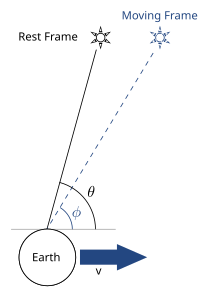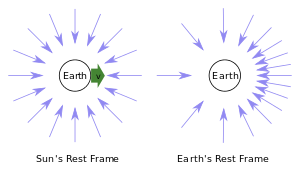
A | B | C | D | E | F | G | H | CH | I | J | K | L | M | N | O | P | Q | R | S | T | U | V | W | X | Y | Z | 0 | 1 | 2 | 3 | 4 | 5 | 6 | 7 | 8 | 9

In astronomy, aberration (also referred to as astronomical aberration, stellar aberration, or velocity aberration) is a phenomenon where celestial objects exhibit an apparent motion about their true positions based on the velocity of the observer: It causes objects to appear to be displaced towards the observer's direction of motion. The change in angle is of the order of where is the speed of light and the velocity of the observer. In the case of "stellar" or "annual" aberration, the apparent position of a star to an observer on Earth varies periodically over the course of a year as the Earth's velocity changes as it revolves around the Sun, by a maximum angle of approximately 20 arcseconds in right ascension or declination.
The term aberration has historically been used to refer to a number of related phenomena concerning the propagation of light in moving bodies.[1] Aberration is distinct from parallax, which is a change in the apparent position of a relatively nearby object, as measured by a moving observer, relative to more distant objects that define a reference frame. The amount of parallax depends on the distance of the object from the observer, whereas aberration does not. Aberration is also related to light-time correction and relativistic beaming, although it is often considered separately from these effects.
Aberration is historically significant because of its role in the development of the theories of light, electromagnetism and, ultimately, the theory of special relativity. It was first observed in the late 1600s by astronomers searching for stellar parallax in order to confirm the heliocentric model of the Solar System. However, it was not understood at the time to be a different phenomenon.[2] In 1727, James Bradley provided a classical explanation for it in terms of the finite speed of light relative to the motion of the Earth in its orbit around the Sun,[3][4] which he used to make one of the earliest measurements of the speed of light. However, Bradley's theory was incompatible with 19th-century theories of light, and aberration became a major motivation for the aether drag theories of Augustin Fresnel (in 1818) and G. G. Stokes (in 1845), and for Hendrik Lorentz's aether theory of electromagnetism in 1892. The aberration of light, together with Lorentz's elaboration of Maxwell's electrodynamics, the moving magnet and conductor problem, the negative aether drift experiments, as well as the Fizeau experiment, led Albert Einstein to develop the theory of special relativity in 1905, which presents a general form of the equation for aberration in terms of such theory.[5]
Explanation
This section needs additional citations for verification. (July 2019) |

Aberration may be explained as the difference in angle of a beam of light in different inertial frames of reference. A common analogy is to consider the apparent direction of falling rain. If rain is falling vertically in the frame of reference of a person standing still, then to a person moving forwards the rain will appear to arrive at an angle, requiring the moving observer to tilt their umbrella forwards. The faster the observer moves, the more tilt is needed.
The net effect is that light rays striking the moving observer from the sides in a stationary frame will come angled from ahead in the moving observer's frame. This effect is sometimes called the "searchlight" or "headlight" effect.
In the case of annual aberration of starlight, the direction of incoming starlight as seen in the Earth's moving frame is tilted relative to the angle observed in the Sun's frame. Since the direction of motion of the Earth changes during its orbit, the direction of this tilting changes during the course of the year, and causes the apparent position of the star to differ from its true position as measured in the inertial frame of the Sun.
While classical reasoning gives intuition for aberration, it leads to a number of physical paradoxes observable even at the classical level (see history). The theory of special relativity is required to correctly account for aberration. The relativistic explanation is very similar to the classical one however, and in both theories aberration may be understood as a case of addition of velocities.
Classical explanation
In the Sun's frame, consider a beam of light with velocity equal to the speed of light , with x and y velocity components and , and thus at an angle such that . If the Earth is moving at velocity in the x direction relative to the Sun, then by velocity addition the x component of the beam's velocity in the Earth's frame of reference is , and the y velocity is unchanged, . Thus the angle of the light in the Earth's frame in terms of the angle in the Sun's frame is
In the case of , this result reduces to , which in the limit may be approximated by .
Relativistic explanation
The reasoning in the relativistic case is the same except that the relativistic velocity addition formulas must be used, which can be derived from Lorentz transformations between different frames of reference. These formulas are
where , giving the components of the light beam in the Earth's frame in terms of the components in the Sun's frame. The angle of the beam in the Earth's frame is thus [6]
Antropológia
Aplikované vedy
Bibliometria
Dejiny vedy
Encyklopédie
Filozofia vedy
Forenzné vedy
Humanitné vedy
Knižničná veda
Kryogenika
Kryptológia
Kulturológia
Literárna veda
Medzidisciplinárne oblasti
Metódy kvantitatívnej analýzy
Metavedy
Metodika
Text je dostupný za podmienok Creative
Commons Attribution/Share-Alike License 3.0 Unported; prípadne za ďalších
podmienok.
Podrobnejšie informácie nájdete na stránke Podmienky
použitia.
www.astronomia.sk | www.biologia.sk | www.botanika.sk | www.dejiny.sk | www.economy.sk | www.elektrotechnika.sk | www.estetika.sk | www.farmakologia.sk | www.filozofia.sk | Fyzika | www.futurologia.sk | www.genetika.sk | www.chemia.sk | www.lingvistika.sk | www.politologia.sk | www.psychologia.sk | www.sexuologia.sk | www.sociologia.sk | www.veda.sk I www.zoologia.sk

















